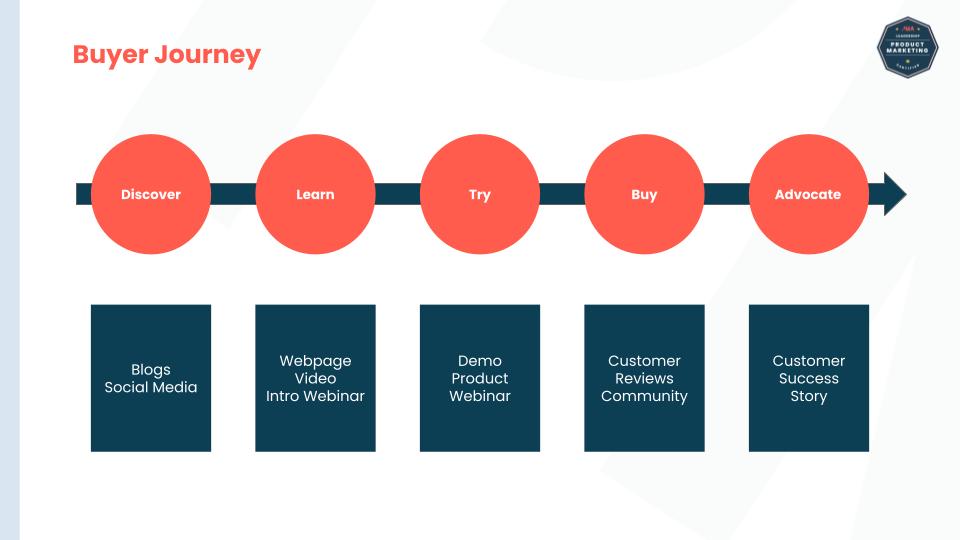
Startup founders and scaleup leaders have been struggling with the marketing vs product marketing conundrum for decades. Sure, some early SaaS companies who went on to become category leaders smashed it and now sit proudly atop their vertical. However, those who know anything about category dominance will often tell you that first to market usually hold most of the market. That’s why everybody wants to be a category creator; they feel it will give them a competitive edge or advantage.
But that’s the wrong play. The truth is, in today's world categories are overcrowded and to cut through the noise you need strong positioning and a clear narrative. To achieve this what you don’t do is copy the positioning of the category leader and hope for the best. What you need to do is build out your product marketing team.
For start-ups, avoid hiring someone for social or for copywriting as your first marketing hire; these are roles you can fill in the short term with part-time or contract team members. Your first hire should be pretty senior, think product marketing manager, and avoid making the costly mistake of hiring a junior marketer because you don’t fully understand marketing or you prioritise sales over marketing.
Building out your product marketing function requires investment but that investment will pay immediate dividends if you hire the right fit. You need expertise with a depth of knowledge who has been involved in go-to-market strategy, sales enablement (even for product-led companies), and proven ability to nail your positioning and craft a winning narrative.
So take this article in; it’s a deep dive into what your product marketing team structure should look like at various stages of your organisation's development.
Product marketing team structure at stages of growth
Most SaaS leaders would accept the following four stages of growth and we suggest the following team size at each particular stage:
|
Early pre-market fit |
1/2 Product marketers |
|
Early post-product market fit |
2/3 Product marketers |
|
Mid-growth with an established go-to-market team |
9 Product marketers |
|
Late growth/scale up |
9 Product marketers |
There is of course flexibility in the numbers depending on the size of your organisation; some late-stage companies have hundreds of product marketers (PMMs) with teams focused on specific functions, goals and objectives. This leads me to the next point of discussion.
Structuring your PMM team by function
There are four key functions to divide your team by:
- Market intelligence
- Messaging and positioning
- Launch and go-to-market strategy
- Sales enablement
However, as functions or topics when you have smaller teams, the key thing here is that sales enablement must be recognised as an early adopted process. It is not a maturing of the sales function at your organisation. In fact, we'd go as far as to say for many sales-led organisations, it's one of the key reasons you struggle for consistency in the sales process and why churn is high amongst business development reps (BDRs).
Planning your internal product marketing team structure
The alternative to structuring your team by function is to do it by:
- Buyers' journey
- Industry or solution
- Function
- Line of business
- Objective or theme
- Feature and aligned with Product
Don't get too wrapped up in choosing one of the options and blindly following it. You have to investigate alongside your PMM team which works best and why. By making this choice inclusive rather than delegated, you’re likely to establish which is suitable faster and get powerful buy-in and support.
When you have the support it's easier to gain transparency on the technical capabilities of your PMMs. Here are a few skills you should look out for and seek:
- Product/solution/industry positioning and messaging
- Managing product launches
- Creating sales collateral
- Customer and market research
- Storytelling
- Reporting on key metrics
- Onboarding customers
- Product roadmap planning
- Customer advocacy/ customer success stories
Which is a great segue into recruitment - the key to team building when skills are short or your incumbent team just isn’t suitable.
Recruiting your first PMM team do’s and don’ts
Recruitment is notoriously difficult. Add in being an early-stage SaaS or founder with a limited budget or a scaling team with underperforming staff, hiring can feel like the wild west (as we all know there are a lot of cowboys out there overselling their capabilities and underdelivering their results). So where do you focus first? We'll dive into the below points in-depth:
- Hire your senior PMMS first
- Job descriptions
- Example job description
- The interview process
- Sample interview questions for Product Manager Roles
- Experience in product marketing disciplines
- Sample interview questions related to GTM
- Interview tasks for Product Marketing Manager roles
- The key skills you’re looking for
As we stated in the very early part of the article, STOP recruiting junior staff for senior roles; hire well early and you will reap the benefits. Our tips for recruiting your senior PMM are:
- Interview with Senior PMM for product marketing calibre/interest
- Interview with the hiring manager for culture/team fit
- Presentation/panel discussion with stakeholders from cross-functional teams - product management, sales, engineering, corporate marketing, sales enablement, etc.
When it comes to writing the job description here are some things to do:
- Get the job title right by clearly communicating expectations and aligning with future business needs. There’s room for fun with the copy in job descriptions but the job title isn’t the place to have it. It needs to be accurate and to the point so people reading it know straight away if they’re right for the role
- Start with a concise, engaging paragraph which summarises the role. This should include what role is and why it’s important for the company
- Get the opinion of your existing team members. They should have great insight when it comes to describing the help they need and how to find the right cultural fit for the company
And here are some things that you shouldn't do:
- Be too specific about the type of personality you’re looking for. Saying you’re looking for someone ‘obsessed with every little detail’ might put some people off who are very good at their job but don’t consider themselves to be overly pedantic
- Simply list their responsibilities without explaining why they’re important. Candidates should be excited about how their role will contribute to the overall business objectives, so tell them about that
- Put great people off by using biased language. Research has shown that gender-coded language can deter women from applying for a job
Some of these are glaringly obvious but some smaller companies won’t have an HR person and could be tempted to just copy a job description off of a jobs board.
Recruitment is about being purposeful, You can’t get to your purpose of recruiting this role if you are copy-pasting someone else’s job and hoping it solves your own situation. When you finally get to the interview stage, try opening with a few questions like these:
- How did you get into product marketing?
- What part of product marketing excites you the most?
- What did you enjoy/hate the most in your prior product marketing roles?
- In which work environment do you thrive?
- What type of work environment hurts your creativity and growth?
Remember, be purposeful. Decide what it is you need from a person in advance and build questions into your interview process to help you understand how this person can help deliver on those goals and objectives.
Your next job is to discover their competencies around product marketing disciplines. Below are key areas you can probe into with supporting questions.
Product Positioning
- Describe the product portfolio at your last company?
- Name a company that is doing a great job at product marketing and why?
- How would you approach positioning a new product for a new buyer persona in our company?
- How have buyer and user personas shaped your strategy in the past?
- Based on the knowledge you have, how would you position the product/solution you are interviewing for?
Managing product launches
- What does good go-to-market planning look like?
- Describe a product launch you worked on. What went well? What would you do differently now?
- How would you help drive adoption if a product launch was not as successful as you planned?
- Thinking of a launch you worked on, what did you do to engage internal and external audiences? What worked best?
- What sales enablement planning did you do at each stage of the launch?
- How do you help cross-functional stakeholders to prioritize and meet product launch timelines?
Conducting customer and market research
- Win/loss data shows that your win rate against a close competitor is decreasing. What steps would you take to address this?
- How should customer feedback drive the product roadmap?
- You get feedback from the sales team that pricing is too high and the win rate is suffering as a result. What would you do to investigate this further?
- What do you consider to be the fundamentals of a good win/loss programme?
Questions about their planning process
- In your opinion, what is the most important information that a go-to-market plan should include?
- Go-to-market requires a huge coordinated effort across several teams, including product, sales enablement, sales, design and content. How would you ensure that collaboration and communication remained strong throughout the process?
- We want to meet our customers in the right place and at the right time. What messaging vehicles would you use to sell our product/service and why do you think they are relevant for our users?
- What experience do you have in terms of working with a budget and predicting a return on investment?
Questions on their research methodology
- Every go-to-market strategy starts with solid research. What questions would you seek to answer in your research?
- It’s very important that our positioning differentiates us from our main competitors. Can you talk a little bit about any experience you have in competitor research?
- How would you start to gather information about our target personas and how we can solve their problems?
- What signs would you look for in your research that would indicate this is the right time to launch a new product?
Questions about brand positioning
- What stands out to you about our brand and how do you think we currently separate ourselves from our competitors?
- Can you point to any specific ways that our brand positioning may influence our go-to-market strategy? Is there anything that you would never do for our brand?
- Can you give an example of a great marketing campaign you saw recently that you felt supported a brand’s market positioning?
- Can you think of any new markets that we could expand into whilst still maintaining a strong brand position and identity?
Questions about voice and messaging
- What key messages from our brand would you incorporate into your go-to-market strategy?
- Thinking of the brands you interact with, how do you like them to communicate with you and why?
- How would you describe our tone of voice and brand personality?
- Do you have any specific ideas for marketing campaigns that would work well with our current tone of voice?
Find out why they’re suited for the role of PMM
- How will you upskill to become an expert in our product, market, customers and industry?
- What would you do in your first 90 days on the job?
- How would your peers assess your strengths and weaknesses?
Question their goals and objectives
- Can you give an example of a time when you have set yourself or your team a list of goals and objectives and used specific metrics to track your success?
- Your objectives and goals may change depending on the specific product but can you list some key objectives that you would always be looking to achieve within any product launch?
- Do you have any experience creating messaging and positioning frameworks and what should a strong framework look like?
- What do you think would be the top area for improvement in our business? How would you incorporate that into your goals?
- How do you measure Product Marketing success?
Further key questions
- How would you define a guest job seeker’s top needs, pain points and requirements in this situation?
- Outline at least two recommendations describing product changes that would meaningfully address the pain points you described above. How did you reach these ideas?
- Outline the high-level research plan you’d use to test, validate and prioritize your ideas, including rationale, key questions, tools/tactics and deliverables for your approach
- Assume research proves your ideas - how would you get the product team’s buy-in?
- Develop positioning and key messaging for your recommended improvements
These questions can help you identify the real skillsets of those you interview and craft insight into their strengths and weaknesses as well as their passions and dislikes. But questions alone will not get you to the finish line. To really dive into the abilities of your interviewee PMM, you need to have tasks.
Further ideas for interview tasks for your PMM
- Ask interviewees to come up with a marketing strategy for one of your products or for an imaginary product to test their creativity and critical thinking skills
- Ask them to redesign the marketing campaign for a product they think is great but is marketed poorly to test how solution-focused they are
- Ask the candidate what key metrics they’d track if they realised there was a significant drop-off in the sales funnel for a particular product or feature. This will identify their analytical mindset and problem-solving skills
- Ask them to demonstrate how they would change their marketing mix if they were selling a software or hardware product? What about if it was B2C or B2B?
And to bring this to an end, here are the key skills that your PMM interviewee or team members must have:
- The ability to inspire and influence
- A sense of curiosity
- A flair for storytelling
These questions and tasks are just suggestions for you and your team to leverage and not simply repeat. Use them as a skeleton and update alter or amend them to help you structure your product marketing team.
The buyers' journey and target audience should play a role in your hiring strategy. Your team or new hires will spend a lot of time building brand awareness and content marketing so that you can improve your lead generation.
Let's dive into why the buyer's journey matters.
Why your customers' buyer journey matters

Building the right product marketing team structure will be impacted by your understanding of your customers' buyer journey. Having a spread of skills amongst the team members will help support the outputs required to move your buyer through your pipeline.
This example from the Product Marketing Alliance shows an example of the buyer journey for SaaS platforms and the content and activities that need executing. You should take your time to make this example your own based on your own personas.
If you are struggling with your personas for any reason, check out this resource which guides you through the persona process.
Given the length and complexity of time, it takes to build a product marketing team, you can be assured that planning is the key requirement. Planning gives purpose, purpose gives direction, and directly leads to exploring for results.
If you have any questions about building your marketing team's structure feel free to reach out and ask. We'd be happy to share notes and pick up new insights.
%20small.jpg)


